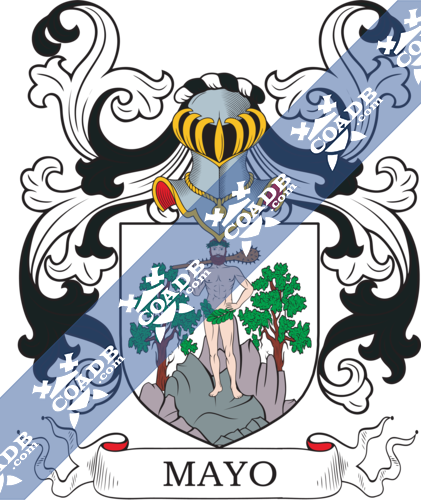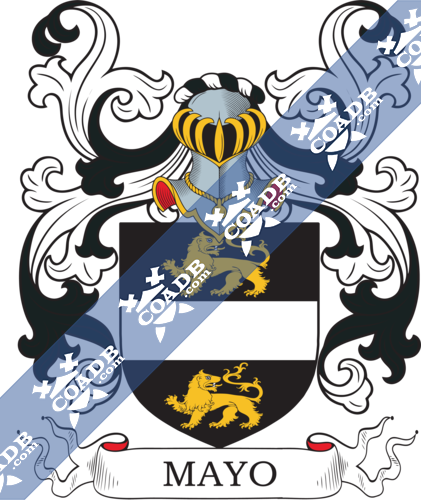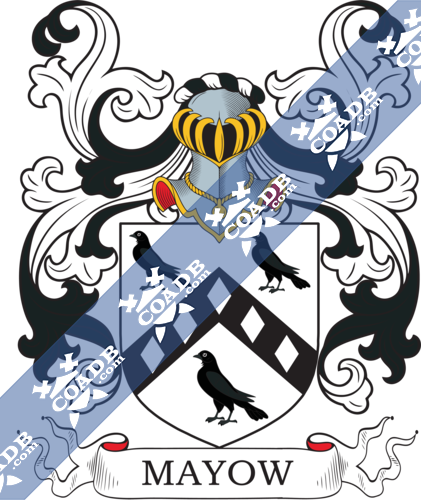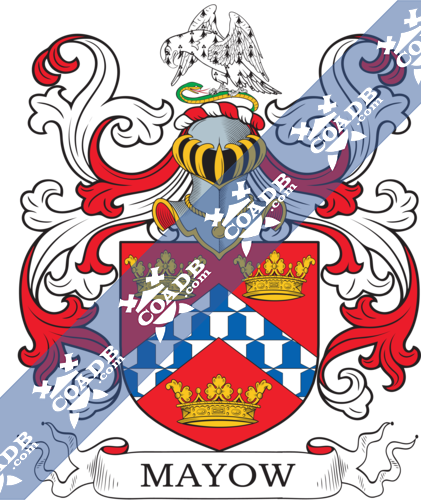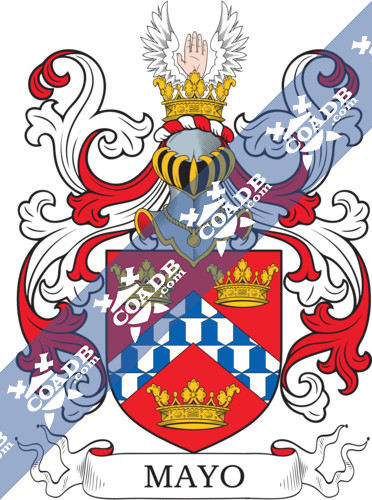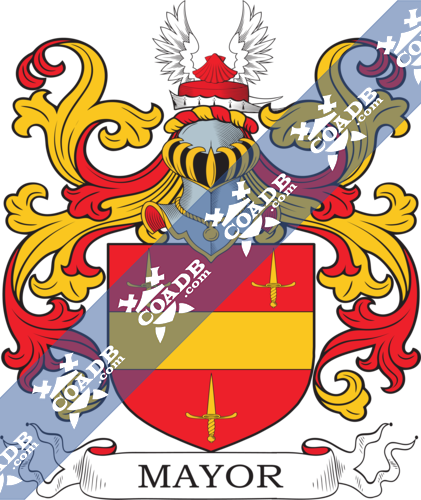Mayo Family Crest, Coat of Arms and Name History
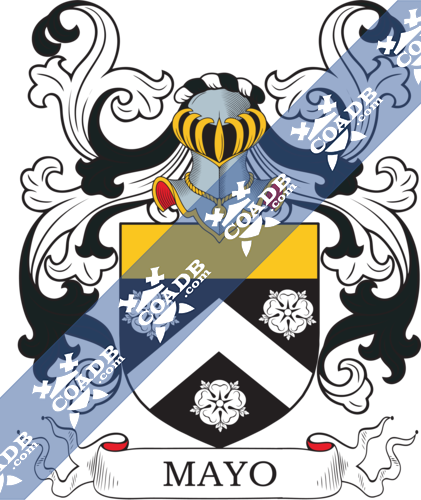
Mayo Coat of Arms Gallery
Don’t know which Coat of Arms is yours?
We can do a genealogical research. Find out the exact history of your family!
Learn MoreMay Origin:
England, France, Germany, Netherlands
Origins of Name:
The surname May is an ancient surname that most likely originates from a Norman French Introduction then to medieval England. The original word it derives from is “mai”. Mai was used as a word as a term of endearment or greeting given to a young person. It was also used as a term of endearment for someone who was a close friend of kin. This trend extends all the way to the 21st century where we see nicknames used for terms of endearment such as “lad” or “dude”, the former which can be used interchangeably between males or females.
The surname could also be used as a pet name or shortened version of the name “Matthew”. Matthew itself with some plural endings could possibly mean “Son of May”. The name Matthew is biblical in origin. It comes from the Hebrew male name “Matityahu” meaning gift of God. The name is recorded in the Greek version of the New Testament in the form of “Matthaias”. It is often seen as a Middle English given name and the modern version “Matthew”.
Finally, many children were often christened with the name “May”. A surname will evolve often times when a baby is christened with a given baptismal name. In this case the May baptismal surname is thought to only have been given to female babies. This is rare as normally there is no gender bias with given names that then eventually evolve into surnames.
Variations:
More common variations are:
Mayo, Mayy, Maey, Mawy, Mayh, Maoy, Maya, Moay, Mauy, Mayi, Mayu, Maay, Muay, Maye, Meay, Miay, Mhay, Maiy, Mway, Hmay,
History:
England:
The first known recorded spelling of the May surname is known as William Mai in 1167 who was recorded in the Pipe Rolls of Norfolk.
In 1177, William le Mai was also recorded in the Pipe Rolls of Norfolk, and it is unknown if there is any relation to the prior William Mai.
In 1221, Thomas le Mey and Goscelin Mey were recorded in the Book of Ely in Abbey Sufolk.
In 1275, John Meys was recorded in Gloucestershire in the Hundred Rolls of Gloucestershire.
Later recordings of the May surname include Stephen Mays in 1332 recorded in the Warsickshire Subsidy Rolls. Ann Mays was christened in the church of St. Mary the Virgain, Aldermanbury in London in 1596.
Scotland:
It is believed the surname is from the Old English word “maeg” meaning male kinsman, and warrior. William May built and settled his line in Berwick in 1291. David May was feudal lord of lands of Chapeltoun of Both in 1587. In 1597, Alexander May appears in Bourhilis, Aberdeenshire records. John Maii was recorded in 1638 in Harvestoun in Tillycultrie and in 1640, Robert Maii was recorded in Dunglas.
The MacDonald clan is notably a form of the name Omay.
Ireland
The surname May in Ireland was written and pronounced differently as it derives from the Gaelic surname O Miadhaigh. May is an Anglicized version of the surname O Miadhaigh, which means “descendant of Miadhach”. The name is also a nickname given to a person that would mean “honorable” or “proud”.
The surname O Miadhaigh is an old Westmeath surname, which can still be found today in the midlands. However, it is more frequently found today in Roscommon and the southern parts of Mayo. Sir Hugh de Lacy was famously killed by a O Miadhaigh, who cut off his head with an axe at the castle of Durrow in 1186. Sir Hugh de Lacy was nicknamed “the profaner and destroyer of many churches”.
The family O Miadhaigh itself was originally located in Teffia. Teffia was a County Westmeat. The family had given their name to the lands and forests known as Clonyveey or Cluain Ui Mhiadhaigh. The Anglecized version of this is O’Mey’s meadow.
As happened to many Irish families of that time they were forced to move off of their homeland by Norman families. During the Norman conquest of England many Norman families were given land, which further spread to Ireland when they would reach its shores too.
May Today:
United States 119,775
Mexico 31,591
England 29,361
South Africa 18,593
Malaysia 14,266
Australia 12,641
Cambodia 9,771
Canada 9,088
Brazil 9,031
Nigeria 6,725
Russia 6,087
Sudan 4,639
France 4,200
Notable People:
Thomas Erskine May (1815-1886), English constitutional expert
Philip William May (1864-1903), English caricaturist
Peter May (b. 1929), English cricket player
Harold May (b. 1947), English guitarist
David LaFrance May (1943-2012), American Baseball outfielder
Bert Deems May (b. 1969), NFL player in the US
Blazons & Genealogy Notes
1) (co. Dorset). Gu. a chev. vair betw. three ducal coronets or. Crest—Out of a ducal coronet or, a sinister hand ppr. betw. two wings ar.
2) (Tottenham High Cross, co. Middlesex; James Mayo, gent., son of Richard Mayo, Esq., of Much Marcle, co. Hereford. Visit. Middlesex, 1663). Sa. a chev. betw. three roses ar. a chief or.
3) Ar. a woodman wreathed about the head and hips walking upon a mount betw. two trees with a club over the dexter shoulder all ppr.
4) Sa. a fesse ar. betw. two lions pass. reguard or. (another coat has a canton ar.).
5) (Dinton, co. Wilts). Ar. (another, or) on a chev. sa. betw. three birds of the last five lozenges of the first.
6 (Lowe and Bray, co. Cornwall; Philip Mayow, Esq., of Bray, son of John Mayow, grandson of Philip Mayow, and great-grandson of Philip Mayow, all of Lowe. Visit. Cornwall, 1620). Gu. a chev. vair betw. three ducal coronets or. Crest—A falcon erm. devouring a snake ppr.

